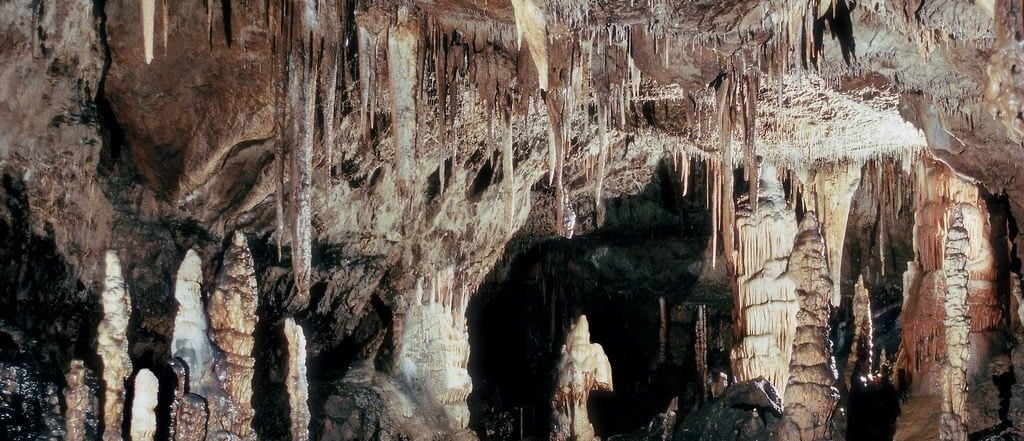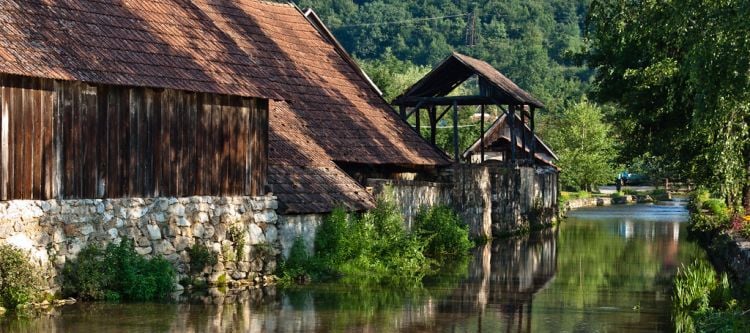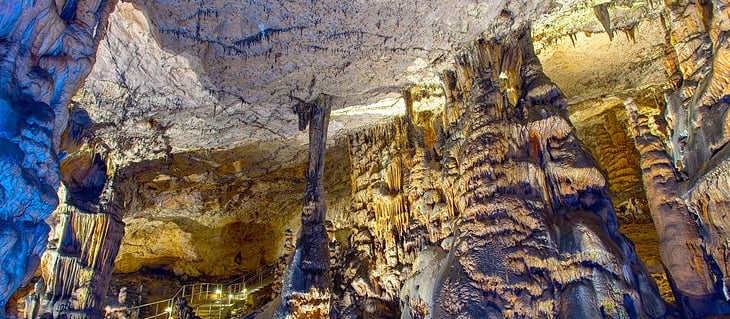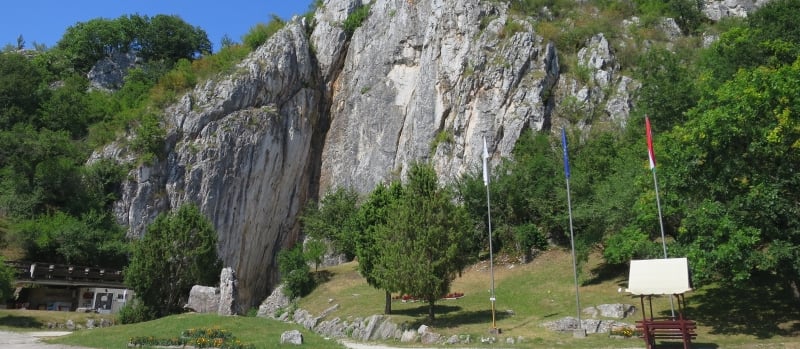Aggtelek National Park
A subterranean marvel and forested paradise where ancient caves, lush valleys, and centuries of tradition converge in transboundary wilderness.


A Living World of Limestone, Forest and Heritage
In northern Hungary rests Aggtelek National Park—a sprawling expanse that merges geological wonder with forested beauty, stretching across the karst plateau and crossing into Slovakia. Formed in 1985 and later expanded, the park now covers over 200 km² of protected terrain, preserving more than 260 caves, dense beech forests, serene ravines, and chalky cliffs. At its heart lies the Baradla–Domica cave system, a UNESCO World Heritage site and one of Europe’s longest connected cave complexes. The surface world is equally compelling: oak–beech canopy, mountain ash-lined gullies, and panoramic ridges that frame valleys rich with wildflowers. For visitors, this is not merely a park—it is a geological gienscape where water and limestone sculpt underground cathedrals, and living woodland supports ancient traditions of shepherding, watermill communities, and folklore-rooted hospitality. Climate, habitat, and human history are inseparable: moss-clad rock steps, reed-lined streams, and fading thatch-roofed huts invite exploration into landscapes shaped by both nature and centuries of respectful human presence.
Aboveground forests transition seamlessly into subterranean wonder, where the limestone's secret depth reveals an underground world stretching dozens of kilometers. The park’s ridge lines and sinkholes help maintain a delicate hydrological and ecological balance that supports both surface and cave biodiversity. Visitors walk beneath canopy-filtered light, cross wooden boardwalks over marsh meadows, and peer into doline ponds shimmering with sunken wood debris and frogspawns. On foggy mornings, birdblitz watchers detect black storks or lesser spotted eagles drifting above surprising clarity. These glimpses of life—whether above or below ground—remind visitors that karst ecosystems are not hollow cathedrals but living systems, where each stone, water drop, and echo connects to intricate cycles of geology and biology.
Cultural Roots: Villages, Traditions, and Artisan Heritage
Aggtelek’s valleys shelter human creativity as much as wild space. Small villages like Jósvafő, Krásnohorské Podhradie, and Szin undergo seasonal occupancy yet retain traditions through guesthouses and herb-walled taverns. Residents raise sheep, produce “herb bread” using cave salt, and craft sheep wool blankets and pony-drawn cart rides. In summer, open-air events reenact shepherd rituals: whip-cracking tosher shows, falcon displays above plateau ridges, storytelling linked to cave lore, and local herbal tastings. Talented aromatic oil makers distill wild thyme and linden blossom into hand-labeled bottles sold at visitors' centers, showcasing crafted local heritage sustained by the landscape.
Churches dating from the 12th century dot meadows and trail junctions. They host candlelit concerts amid hallowed halls, linking legend and limestone soundscapes. Regional festivals—such as Candlemas Procession or Deer Hunt Day—bring visitors in historical costume to woods for poetry, folk dance, and communal fires. Such events reinforce community identity under open sky. Lodging is modest: family-run pensions in valley hamlets, century-old cottages with herb-lined kitchens, and eco-huts built from timber reclaimed at ridge edges. Even the park’s visitor centers encourage slow connections—hand-carved benches, written guides in multiple languages, and volunteer-run herb gardens to support pollinators. Cultural life here is rooted in the wild but expressed visibly through testimony of tradition maintained in partnership with nature.
Conservation Ethos and Research Integration
Aggtelek National Park operates with robust scientific insight and community partnership. Its protected zones include cave complexes, endemic flora areas, and old-growth forest reserves. The park facilitates international speleological research into cave ecology, hydrology, fossil stratification, and microclimate. European bat population tracking takes place inside select cave galleries using infrared cameras and tagging studies. Flora studies monitor spring ephemeral bloom cycles and forest succession. The park restricts cave entrances during breeding seasons, regulates visitor flow, and restores degraded trails to limit erosion. Local herders continue to graze plateau pastures in managed rotation—not as relics, but as land-shaping biodiversity guardians who prevent forest succession and support grassland specialist species.
Knowledge-sharing extends to schools, universities, and NGOs across Hungary and Slovakia. Joint Information Centres along border zones support bilingual programs, cross-border bird monitoring, and karst water share management. The park publishes open ecosystem data and sponsors ecotourism plans that include ranger-guided tours, low-impact lodging, and sustainable product cooperatives. In this model, conservation becomes a living practice, not invisible barrier—allowing tourism and traditional management to coexist within a sustainable ecological framework that honors transboundary collaboration, scientific transparency, ethical tourism, community co-management, and landscape resilience.
Practical Information
Aggtelek National Park is located in northern Hungary, near the village of Aggtelek and bordering Slovakia. Visitor Centres are found at Jósvafő and Szin with multilingual maps, guided tour bookings, and café services. The park is open year-round; cave tours operate spring through autumn, often requiring pre‑booking. While entry to forest trails is free, specialized tours—such as the Baradla deep tour, night cave trips, or ranger-led fauna surveys—carry fees of approximately 2,000–4,000 HUF. Access is provided via regional rail to Aggtelek station, with shuttle buses to villages and trailheads. Accommodation includes eco-lodges, guesthouses, and cave‑side hostels. Trails range from flat forest walks to demanding traverse routes requiring layered clothing, sturdy footwear, and headlamps. Visitors should carry water and snacks, adhere to cave rules (no photography in certain chambers), and inform park officials if venturing off-route. Dogs on leash are permitted outside caves. Seasonal hazards include ice surfaces in caves, sudden thunderstorms on ridges, and muddy trail sections. Public restrooms, water taps, and first aid stations are available near main villages.
Official Links
For trail maps, ticket reservations, seasonal programming, and educational materials, visit the official site:
https://agict.hu/
See wildlife updates, cave photography, and conservation insights on social media:
Instagram: @agteleknemzetipark
Facebook: Aggtelek National Park Directorate


Subterranean Majesty: The Baradla–Domica Cave System
Central to Aggtelek’s appeal is its dramatic subterranean treasure: the Baradla–Domica cave system. Formed over millions of years, these extensive cave galleries reach beyond 24 km in Hungary and continue into Slovakia, showcasing towering stalagmites, intricate flowstone curtains, subterranean waterfalls, and expansive chambers lit by soft lighting. Guided tours open pathways through cavernous halls such as Concert Hall, boasting excellent natural acoustics used for musical performances during summer evenings. Inside, temperature remains near 10–12 °C year-round, humidity thick enough to let pilgrims feel breath turn mist in certain passages. Archaeological evidence reveals that prehistoric humans sheltered in these caves, adding layers of human resonance to their natural drama.
The caving experience is one of quiet revelation: visitors descend along damp carved staircases, watching silent limestone towers glow in golden light, and sound drips echo between benches shaped by geological patience. Seasonal programs include candlelit tours, geology lectures mid-cave, and guided spelunking treks to less accessible, unlit passages. For those seeking experiential depth, the park offers educational "spéléo" weekends with basic ropework instruction and biological sampling in accessible caverns. Every level of sport and knowledge finds place: from casual explorers to ecology students mapping fluorescent cave bacteria. The caves are alive: tiny cave spiders harvest mineral vapors, temperature shifts cascade water flow into pond basins, and stalagmite growth continues imperceptibly—reminding us that caves are not relics but still-breathing chronicles of geological time.
Forests, Fauna, and Wilderness Trails
Above the caves, Aggtelek’s surface consists of karst forest, ravine slopes, pasture-fed ridges, and old-growth pockets hosting remarkable fauna. Forest meadows bloom with orchids, lilies, and rare shade-loving ferns. Oak and beech trees flourish at mid elevation, with wild cherry, elderberry, and mountain ash lining forest edges. Wildlife abounds: Eurasian badgers dig under forest litter, woodpeckers rap at trunks, small mammals scurry across logs, and roe deer graze at dawn. Rare amphibians—Alpine newts, fire salamanders—inhabit hidden pools enriched by spring seepage. Raptors such as Eurasian buzzards, common buzzards, and goshawks patrol overhead, while bats roost in caves, emerging at dusk for aerial insect hunting.
Trail networks span well-marked routes and rugged ridge hikes: the so-called Lifestyle Trail circumnavigates forest blocks and sinkholes, while demanding multi-day treks like Ménes-patak ridge ascend ridgelines with panoramic views of fields and fir woodlands. The park encourages self-guided wandering but also offers ranger-led ecological walks emphasizing karst hydrology, forest restoration, and traditional land use such as shepherd fires or stacking hay by pony-driven carts. Each path invites connection: foot traffic feels deliberate, woven through forest dells, time-weathered limestone outcrops, and silent altitude transitions between wet hollows and dry ridge tops. Wilderness is defined not by absence of human presence but by quiet interplay between forest ecology and low-impact visitation.






Awarded with the Highest Distinction
Aggtelek National Park received the Excellence Award for its remarkable fusion of geological grandeur, biodiversity richness, living tradition, and scientific-conservation integration. It is a destination well worth the trip—not simply for its underground cathedrals or ancient forest—but for offering a profound encounter with nature, culture, and time across the karst highlands of Central Europe.






